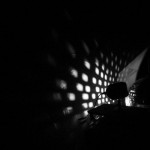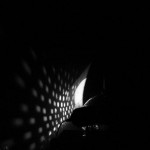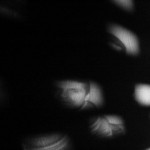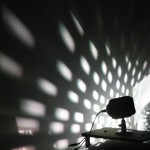EMBEDDEDINVISIBLE
EMBEDDEDINVISIBLE
Exhibition #4
hu-fAk:off space, Vienna, Austria
website of the event
Artists:
Wagner Felipe Dos Santos | Miriam Hamann | Martina Menegon & Stefano D’alessio |
Liddy Scheffknecht | Anna Vasof
Curator:
Işın Önol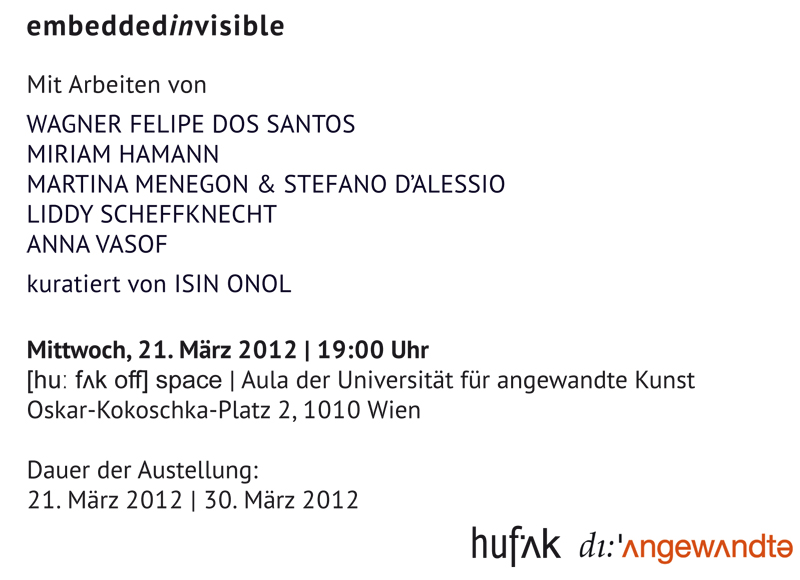
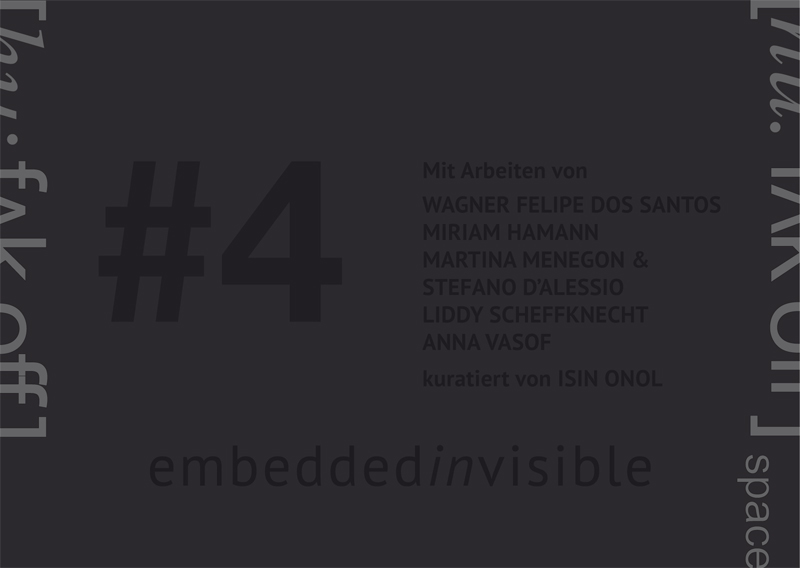
“The Perfect clarity of intelligible light is achieved as a progressive recovery from the displacement of light, which in the sensible realm is ambiguously differentiated from unrepresentable material obstacles, like the tain of a mirror, the bodies which cast shadows, the water’s reflective surface, the cloth divider or the walls of the cave.”[1]
embeddedinvisible invites a group of artists who are working with the key concepts of: visibility-invisibility; subtlety, light, darkness, and shadow, for finding possibilities in spreading information not directly through light but through shadows and darkness as a response to the existing global politics in relation to the association between information, knowledge and light, as opposed to the dominant knowledge production and distribution systems. It invites the audience to stay longer at the exhibition area to explore the work that is not explicitly illuminated for the information not to be lost in visibility but seen within invisibility.
WAGNER FELIPE DOS SANTOS
Self-portrait
Light installation, disco ball, beamer, camera, 2012
In Self-portrait, the observer is imaged in various ways. By approaching the object, the viewer will only appear out of focus behind a unpredictable mask. When the viewers find certain ways to position themselves before the work, their image cast through the beamer gradually become sharper and get unmasked, until the viewer encounters his own image as if looking at the mirror. The interactive portrait shows the direct relation between distance and appearance and the “see and be seen” with an otherwise seemingly uninvolved observer.
Wagner Felipe dos Santos, born 1978 in Tubarão, Brazil, learned classical guitar and composition in Brazil. His been occupied within the areas of electro-acoustic music and the trans-medial art in Vienna. He works with sound machines, interactive objects, installations, live electronics, electroacoustic and instrumental compositions, songs and radio plays and this broad artistic background is reflected in his work in various modes of production.
MIRIAM HAMANN
Coded mind
Two channel sound installation, 2012
Codes determine our daily usage of the Internet. On the computer and on the smartphone the way to the World Wide Web is not more than a click away. Codes and passwords are part of an almost unlimited access to information. They also give us the possibility to share personal experience with other people. In doing so the keyboard serves as a gate, as a medium between private and public. Thus personal thoughts are recorded and even supposedly private notes could be read by governmental security agencies or computer hackers.
Coded mind takes up the idea of the keyboard as a pathway from private to public. The piece begins with the typing and saving of personal, diary-like notes. It deals with the sound that is generated by using the keyboard. In the second part of the work the flow of thoughts is retyped and rerecorded while playing the uploaded sound. The repeated act of typing is supposed to mirror the media.
Coded mind is a reference to Nam June Paik’s installation “TV Buddha” in which a Buddha faces his own image on a TV-screen recorded by a closed-circuit camera. Analogous to that installation my work focuses on the possibility of the alleged private becoming public simply by using the keyboard.
Miriam Hamann, born in Wels/ Upper Austria, studied graphic design at ESAG – École Supérieure d’Arts Graphiques, Nouvelle Sorbonne, Paris. Receiving a Research scholarship from Paris Internship at the Gallery Emmanuel Perrotin, Paris she also studied Art and Communication Practices (Erwin Wurm, Barbara Putz-Plecko) at University of Applied Arts, Vienna and Romance Studies, French at the University of Vienna. Currently she is pursuing her studies at the department of TransArts, University of Applied Arts Vienna with her iploma thesis titled Sopie Calle’s view – Mise-en-scène between authenticity and fiction.
MARTINA MENEGON & STEFANO D’ALESSIO
Doppelgänger
Interactive installation, a computer, a monitor, a USB webcam, 2012
In Doppelgänger the viewer encounters a black screen that is standing in the space. No images can be seen through it at the first glance and it reproduces no sound. At the first impression it seems as just a switched off screen. But as far as someone is passing in front of it, or is just standing near to it and moving, something appears on the monitor and suddenly disappears again. The screen is not only a simple monitor, but it is a shadow in front of what is real. In fact, by moving, it is possible to delete the darkness, and let the image be visible. The screen is a shadowed kind of mirror, but despite of simple mirroring, it shows only what is moving, it shows only what is acting in the real-time, and delete what is static.
Martina Menegon and Stefano D’Alessio live and work in Vienna. They both graduated from Visual and Performing Arts at University IUAV of Venice in 2010. They currently are students in Brigitte Kowanz Transmedial Art class at the University of Applied Arts in Vienna. In the past two years they have been working together, mainly realizing multimedia and interactive performances as well as installations that involve the use of real bodies to investigate the codification of the “so called real” into its digital representation and deformation. When they don’t work together, Martina Menegon is mainly producing motion graphic video animations, while Stefano D’Alessio concentrate more on the realization of electroacoustic music.
Since 2010 they have been working as the assistants for the courses of Klaus Obermaier at the IUAV University of Venice, for whom they also work as programmers for his dance performance entitled The concept of…here and now. Recently they collaborated in the realization of Muybridge! Muybridge!, a theatre performance by Filippo Andreatta. They also took part in the realization of the interactive parts of the dance performance Metamorphico by Anagrama Coreografico.
LIDDY SCHEFFKNECHT
seven minutes fifty four seconds,
video montage, 7 min 54 sec, 2010
The black and white image shows a gaze through a gate. Behind the gate, there is an idyllic countryside setting. On first sight it seems to be a typical photo – a still image capturing a single moment in time. The leaves of the trees seem frozen, the cars don’t move, the earth stands still on a bright sunny day. A shadow of a figure is casted on the foreground of the image. Transcending the border between moving and still image the shadow starts to grow slowly. Its source stays behind the gate, invisible to the spectator.
Liddy Scheffknecht, born in Dornbirn, Austria in 1980, is a visual artist living and working in Vienna. She graduated from the École Nationale Supérieure des Beaux-Arts in Paris and the University of Applied Arts Vienna where she is currently pursuing her PhD.
Since 2001 she participated in numerous exhibitions like the Biennale of Young Artists of Europe and the Mediterranean 2009 or the Moscow Biennale for Young Art 2010. In 2012 she will be participating the 4th Sinop Biennale in Turkey.
Liddy Scheffknecht works in various media including photography, video, installation and sculpture. In her work she concentrates on the subject of time and space, standstill and movement and the borders of static and moving image.
ANNA VASOF
Falling Steps
Object, mixed media, 2012
Falling Steps is a manual video machine, which is combined from a cube and a winder. Each time that the winder is turned, the cubical space is rotated 90 degrees. Every side of the cube has a model staircase in scale 1:10 and a wall, on which there is a human shadow. The animation, which is produced through this process, shows the human shadow trying to step up or down the stairs, but in every position that he achieves, the step under him is falls. The human shadow, even if it moves continuously, remains in the same position without being able to move up or down. The fall of the steps, which appears each time that the model cube rotates, occurs because of the gravity. The project falling steps is an attempt to combine architecture and stop motion animation in order to indicate the difficulty that we experience sometimes in trying desperately to move up or down when the word around us is actually collapsing.
Anna Vasof is an architect and media artist. Born in Prague in 1985, from Greek and Syrian parents, she studied architecture at the University of Thessaly (2010) and now continues her studies at the University of Applied Arts in Vienna, under the tuition of Brigitte Kowanz in the Transmedia Art class. Since 2004 her videos and short movies have been presented in several festivals, some of them winning distinctions. She’s currently working on designing and building innovative mechanisms for producing critical videos.
[1] Textures of Light: Vision and Touch in Irigaray, Levinas and Merleau-Ponty, Routledge, New York, 1998, p. 8
photographs by the artists of the exhibition
